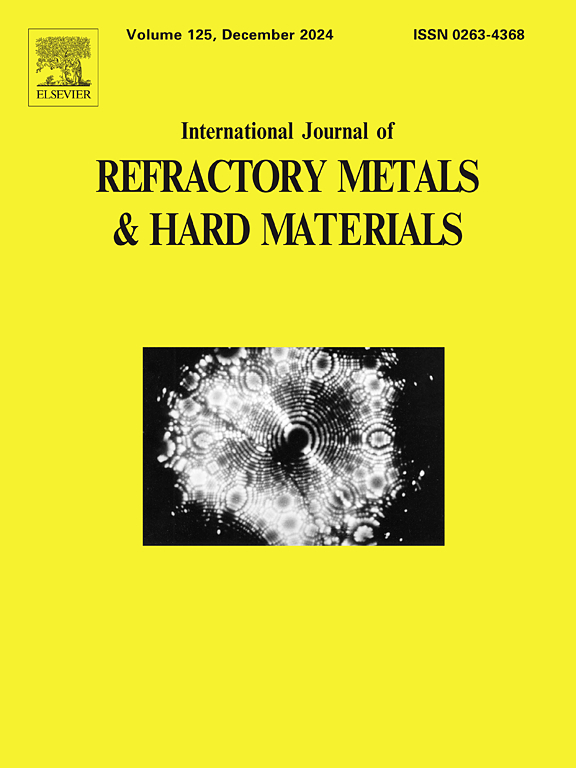Carbon-mediated interface structure and mechanical properties in TiB2-WC cermets: From microstructure to performance
IF 4.2
2区 材料科学
Q2 MATERIALS SCIENCE, MULTIDISCIPLINARY
International Journal of Refractory Metals & Hard Materials
Pub Date : 2025-02-24
DOI:10.1016/j.ijrmhm.2025.107118
引用次数: 0
Abstract
We systematically investigated the influence of carbon content (0–1.05 wt%) on the microstructure and mechanical properties of TiB2-WC-based cermets prepared via vacuum liquid-phase sintering. Carbon addition facilitated oxide impurity reduction and enhanced wettability between the liquid binder and ceramic particles, promoting TiB2 and WC dissolution-precipitation within the CoNi binder. This led to the formation of a distinctive TiB2 core-(Ti, W, Co, Ni)(B, C) rim structure with coherent interfaces. The optimal carbon content of 0.60 wt% yielded superior mechanical properties: transversal rupture strength of 1578 ± 26 MPa, indentation fracture toughness of 11.05 ± 0.31 MPa·m1/2, and hardness of 20.12 ± 0.17 GPa. However, excessive carbon content increased W atom concentration in the CoNi binder, inducing solid solution hardening that compromised overall toughness.
TiB2-WC陶瓷的碳介面结构和力学性能:从微观结构到性能
系统地研究了碳含量(0-1.05 wt%)对真空液相烧结制备的tib2 - wc基陶瓷显微组织和力学性能的影响。碳的加入促进了氧化物杂质的还原,增强了液体粘结剂与陶瓷颗粒之间的润湿性,促进了TiB2和WC在CoNi粘结剂中的溶解沉淀。这导致形成独特的TiB2核心-(Ti, W, Co, Ni)(B, C)边缘结构,具有相干界面。当碳含量为0.60 wt%时,材料的横向断裂强度为1578±26 MPa,压痕断裂韧性为11.05±0.31 MPa·m1/2,硬度为20.12±0.17 GPa。然而,过量的碳含量增加了CoNi粘结剂中的W原子浓度,导致固溶体硬化,降低了整体韧性。
本文章由计算机程序翻译,如有差异,请以英文原文为准。
求助全文
约1分钟内获得全文
求助全文
来源期刊
CiteScore
7.00
自引率
13.90%
发文量
236
审稿时长
35 days
期刊介绍:
The International Journal of Refractory Metals and Hard Materials (IJRMHM) publishes original research articles concerned with all aspects of refractory metals and hard materials. Refractory metals are defined as metals with melting points higher than 1800 °C. These are tungsten, molybdenum, chromium, tantalum, niobium, hafnium, and rhenium, as well as many compounds and alloys based thereupon. Hard materials that are included in the scope of this journal are defined as materials with hardness values higher than 1000 kg/mm2, primarily intended for applications as manufacturing tools or wear resistant components in mechanical systems. Thus they encompass carbides, nitrides and borides of metals, and related compounds. A special focus of this journal is put on the family of hardmetals, which is also known as cemented tungsten carbide, and cermets which are based on titanium carbide and carbonitrides with or without a metal binder. Ceramics and superhard materials including diamond and cubic boron nitride may also be accepted provided the subject material is presented as hard materials as defined above.

 求助内容:
求助内容: 应助结果提醒方式:
应助结果提醒方式:


